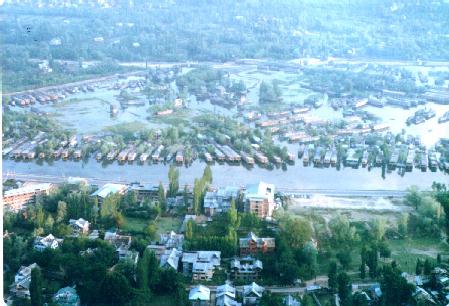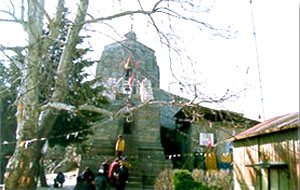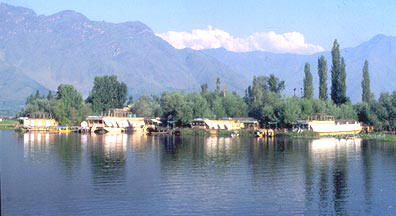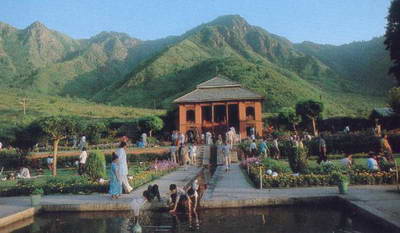|
Location:
Kashmir Region, J&K
Main Attractions: Canals,
Houseboats & Mughal Gardens
Significance: Capital Of
J&K
Best Time To Visit: In
Summer - June To Early November
In Winter - December To February
Srinagar is as much imagination as it is fact, for
every season offers new vistas to this city of great
antiquity. Spring breathes life again into a frozen
world and the air is heady with the fragrance of a
million flowers that blossom on trees, shrubs and
creepers. Summer heightens the effect and autumn is
poignant in its colours of warm introspection. Winter
brings with it snow, sometimes the Dal Lake freezes
and beneath a leaden sky, roasted chestnuts turn the
atmosphere aromatic with the promise of warmth and
comfort.
 Srinagar
district is situated in the centre of Kashmir Valley,
is surrounded by five districts. In the north it is
flanked by Kargil, in the South by Pulwama,in the
north-west by Budgam. The capital city of Srinagar,is
located 1730 metres above sea level. The district with
a population of around 9,00,000 souls(1991- census),
is spread over an area of 2228 Sq.Kms.It comprises
three tehsils/ towns via Srinagar, Ganderbal and
Kangan, four blocks (Srinagar, Ganderbal, Kangan and
Leh), besides 175 villages.The population density in
the district Srinagar is 401 per Square Kilometer
which is highest in the state. The literacy rate of
the district was 33.80%in 1981. Srinagar
district is situated in the centre of Kashmir Valley,
is surrounded by five districts. In the north it is
flanked by Kargil, in the South by Pulwama,in the
north-west by Budgam. The capital city of Srinagar,is
located 1730 metres above sea level. The district with
a population of around 9,00,000 souls(1991- census),
is spread over an area of 2228 Sq.Kms.It comprises
three tehsils/ towns via Srinagar, Ganderbal and
Kangan, four blocks (Srinagar, Ganderbal, Kangan and
Leh), besides 175 villages.The population density in
the district Srinagar is 401 per Square Kilometer
which is highest in the state. The literacy rate of
the district was 33.80%in 1981.
According to a popular legend which is mentioned in
Kalhana's Rajtaringini Kashmir valley was a vast lake.
Kashyap Rishi drained out the water and made it
habitable. It is said that originally Yakshas, and
Pisacas tribes inhabited the valley at the higher
reaches and did not allow the inhabitants of the
valley to live in peace. King Ashok brought Budhism to
Kashmir which was strengthened by Kanishka. In 6th
century Huns came to rule the valley and Mihirkul was
one of the infamous Hun ruler. The area attained
freedom in 530 AD which was short-lived.
According to Sir Aurel Stein the famous interpretor of
Kalhana the chronicler of Kashmir the city of
Srinagar had big market and mansions made of wood
touching the clouds. Hieun-tsang the famous Chinese
traveller visited Srinagar and has described it his
memoirs.
Holy Palace
Hazratbal Shirne
The
Hazrathalbal Shirne, which is situated on th e
left bank of the famous Dal Lake in Srinagar. This
unmatched reverence is anchored in the love and
respect for the Prophet Mohammad (peace be upon him),
whose Moi-e-Muqqadas, (the sacred hair) is preserved
here. The shirne is known by many names including
Hazrathbal , Assar-e-Sharief, madinat-us-Sani, Dargah
Sharief and Dargah.Sadiq Khan,laid out a garden here
and constructed a palatial building, Ishrat mahal or
Pleasure House, in 1623. The construction of the
present marble structure was started by the Muslim
Aquaf Trust headed by Sheikh Mohammad Abdullah in 1968
and completed in 1979.The Moi-e-Muqqadas is displayed
on various occasions related with the life of the
Prophet and his four holy companions. e
left bank of the famous Dal Lake in Srinagar. This
unmatched reverence is anchored in the love and
respect for the Prophet Mohammad (peace be upon him),
whose Moi-e-Muqqadas, (the sacred hair) is preserved
here. The shirne is known by many names including
Hazrathbal , Assar-e-Sharief, madinat-us-Sani, Dargah
Sharief and Dargah.Sadiq Khan,laid out a garden here
and constructed a palatial building, Ishrat mahal or
Pleasure House, in 1623. The construction of the
present marble structure was started by the Muslim
Aquaf Trust headed by Sheikh Mohammad Abdullah in 1968
and completed in 1979.The Moi-e-Muqqadas is displayed
on various occasions related with the life of the
Prophet and his four holy companions.
Shankaracharya Temple
It is
located at 1100ft.above surface level of the main city
o n
the Shankaracharya hill, also known as Takht-e-Suleiman.
The shiva temple, as Kalhana belives, was constructed
by Raja Gopadatya in 371 B.C.and as such is the oldest
shirne in Kashmir. Dogra ruler,Maharaja Gulab Singh,
constructed stone stairs upto the temple. In 1925,the
temple was electrifed. The temple, besides a prominent
religious place of Hindus, is of great archaeological
importance. The temple commands a magnificient
panoramic view of the Srinagar city. n
the Shankaracharya hill, also known as Takht-e-Suleiman.
The shiva temple, as Kalhana belives, was constructed
by Raja Gopadatya in 371 B.C.and as such is the oldest
shirne in Kashmir. Dogra ruler,Maharaja Gulab Singh,
constructed stone stairs upto the temple. In 1925,the
temple was electrifed. The temple, besides a prominent
religious place of Hindus, is of great archaeological
importance. The temple commands a magnificient
panoramic view of the Srinagar city.
Khanqah-e-Molla
The
shrine of Shah-e-Hamdan or Khanqah-e-Moulla is one of
the oldest Muslim shrines in Kashmir situated on the
bank of the river Jhelum in the old city
Jama Masjid
 It
is one of the oldest and the most spacious of all the
mosques in Kashmir, situated in the heart of the
city.The foundation of the mosque, an architectural
wonder was laid by Sultan Sikander in 1398 A.D.The
area of the mosque is 384ftX381ft. spacious enough for
over thirty thousand people to offer prayers at a time It
is one of the oldest and the most spacious of all the
mosques in Kashmir, situated in the heart of the
city.The foundation of the mosque, an architectural
wonder was laid by Sultan Sikander in 1398 A.D.The
area of the mosque is 384ftX381ft. spacious enough for
over thirty thousand people to offer prayers at a time
Khir Bhawani Temple
Situated at Tullamula in the Srinagar district,is an
important hindu shrine. The temple is associated with
the Hindu Goddess, Ragnya Devi. An annual festival is
held here on Jesht Ashtami (May-June) when Hindus
visit the place in large numbers to offer prayers and
seek the blessings of the deity. In addition ,there
are umpteen places of religious importance in Srinagar.
Chatti Padshahi
Chatti Padshahi, one of the most important Sikh
Gurudwaras in Kashmir.The sixth guru of Sikhism
traveled through Kashmir, stopping to preach
occasionally. It is situated just outside the
southern gate of Hari Parbat fort.
Places to
Interest
Dal Lake
 The
world famous water body described by Sir Walter
Lawerence as the "Lake par-excellence", half a
kilometers from the city, is the jewel in the crown of
kashmir eulogized by the poets and abundantly praised
by the travellers and tourists. The lake of late has
unfortunately, considerably shrunk in size causing
concern to environmentalists. The Governments have
chalked out an ambitious project to save the lake from
extinction. The lake is 6X3 km divided by causeways
into four parts, Gagribal ,Lokut Dal,Bod Dal and Nagin.
Two islands, Sona Lank and Ropa Lank, with in the lake
add to its beauty. Nagin is the most lovely part of
the Dal Lake separated by a causeway. The
world famous water body described by Sir Walter
Lawerence as the "Lake par-excellence", half a
kilometers from the city, is the jewel in the crown of
kashmir eulogized by the poets and abundantly praised
by the travellers and tourists. The lake of late has
unfortunately, considerably shrunk in size causing
concern to environmentalists. The Governments have
chalked out an ambitious project to save the lake from
extinction. The lake is 6X3 km divided by causeways
into four parts, Gagribal ,Lokut Dal,Bod Dal and Nagin.
Two islands, Sona Lank and Ropa Lank, with in the lake
add to its beauty. Nagin is the most lovely part of
the Dal Lake separated by a causeway.
Nagin Lake
Known as th e
'Jewel In The Ring', Nagin is generally held to be the
most beautiful of the Dal lakes. Its name comes from
the many trees, which encircle the small, deep blue
lake. Nagin is only separated from the Larer Dal lakes
by a narrow causeway and it also has a number of
houseboats moored around its perimeter. s e
'Jewel In The Ring', Nagin is generally held to be the
most beautiful of the Dal lakes. Its name comes from
the many trees, which encircle the small, deep blue
lake. Nagin is only separated from the Larer Dal lakes
by a narrow causeway and it also has a number of
houseboats moored around its perimeter. s
A Nice
Getaway
If one wants to really get away from the chaotic city
life all then Nagin is a good place to find a house
boat and do it the surroundings are much more serene
and isolated than on Dal Lake. One can rent rowboats
from the camping site here - either to simply row
around the lake or to look around for a houseboat.
Amusements
Since the water in Nagin is deeper and less polluted
it's also good for swimming and there are fiberglass
sailing boats available for hire and water skiing
facilities. Motorboats are rather low powered for
skiing although they make a valiant attempt. If one
wants to try water skiing keep a wary eye out for
swimmers. Likewise, if one is swimming watch out for
the boat drivers.
The Nagin club, on the bank of the lake, has a bar and
a tea pavilion. It is a branch of the Srinagar club
and temporary membership is available to visitors.
Cheshma Shahi and Pari Mahal
 Cheshma
Shahi or the Royal Spring was laid by Shah Jahan in
1632 A.D. It is 9 Km. from the city centre and is
famous for a spring of refreshment digestive water.
Two kilometers uphill from Cheshma Shahi is situated
the Pari Mahal,a school of astrology founded by Prince
Dara Shikoh, Emperor Shah Jahan's eldest son who was
killed in the war of succession. The Cheshma
Shahi-Pari Mahal area has been developed into a
Tourist Village. Cheshma
Shahi or the Royal Spring was laid by Shah Jahan in
1632 A.D. It is 9 Km. from the city centre and is
famous for a spring of refreshment digestive water.
Two kilometers uphill from Cheshma Shahi is situated
the Pari Mahal,a school of astrology founded by Prince
Dara Shikoh, Emperor Shah Jahan's eldest son who was
killed in the war of succession. The Cheshma
Shahi-Pari Mahal area has been developed into a
Tourist Village.
Nishat Garden
Queen Nur Jahan's
brother, Asif Khan ,laid the Garden in 1633 A.D. It is
situated on the banks of the Dal Lake in the backdrop
of the Zabarwan hills,11 Km from the district
headquarter of Srinagar. The Garden commands a
magnificent view of the lake.
The Nishat
Bagh is another lovely garden with its 12 terraces
representing the 12 signs of the zodiac, which descend
gradually and seem to almost merge into the lake. It
is situated on the banks of world famous Dal Lake in
the backdrop of Zabarwan hills. With its flowerbeds,
trees, fountains, the Nishat presents a dramatic
sight. The gardens were designed in 1633 by Asaf Khan,
brother of Nur Jahan, and follow the same pattern as
the Shalimar gardens with a polished stone channel
running down the centre and a series of terraces.
It's the largest of the Mughal gardens measuring 548
metres by 338 metres, and often the most crowed. The
walks beside the channel are bordered with lines of
cypresses and Chinars. Also found within its vicinity
are some remains of Mughal period buildings including
a double storey pavilion enclosed on two sides
latticed windows.
Shalimar Garden
 The
Garden,15 Kms from the city centre, was built by
Emperor Jahangir for his beloved wife, Nurjahan. The
gardens with four terraces is 539 by 182 meters and
gets water from Harwan through a canal lined with
fountains. The fourth terrace was once reserved for
royal ladies. The
Garden,15 Kms from the city centre, was built by
Emperor Jahangir for his beloved wife, Nurjahan. The
gardens with four terraces is 539 by 182 meters and
gets water from Harwan through a canal lined with
fountains. The fourth terrace was once reserved for
royal ladies.
The garden
is built in four terraces with traditional water
channel running down the middle. The gardens measure
540 by 183 metres. During the Mughal period the top
terraces used be reserved for the emperor and the
ladies of the court and was the most magnificent. It
included a pavilion made of black stone in the middle
of the tank. Black Marble fluted pillars supported the
pavilion, which was used as a banquet hall.
Shalimar Bagh has an air of seclusion and repose, and
its rows of fountains and shaded trees seem to recede
towards the snowcapped mountains. A Son Et Lumeiere or
sound and light show is put on here every evening
during the May to October tourist season.
|


 Srinagar
district is situated in the centre of Kashmir Valley,
is surrounded by five districts. In the north it is
flanked by Kargil, in the South by Pulwama,in the
north-west by Budgam. The capital city of Srinagar,is
located 1730 metres above sea level. The district with
a population of around 9,00,000 souls(1991- census),
is spread over an area of 2228 Sq.Kms.It comprises
three tehsils/ towns via Srinagar, Ganderbal and
Kangan, four blocks (Srinagar, Ganderbal, Kangan and
Leh), besides 175 villages.The population density in
the district Srinagar is 401 per Square Kilometer
which is highest in the state. The literacy rate of
the district was 33.80%in 1981.
Srinagar
district is situated in the centre of Kashmir Valley,
is surrounded by five districts. In the north it is
flanked by Kargil, in the South by Pulwama,in the
north-west by Budgam. The capital city of Srinagar,is
located 1730 metres above sea level. The district with
a population of around 9,00,000 souls(1991- census),
is spread over an area of 2228 Sq.Kms.It comprises
three tehsils/ towns via Srinagar, Ganderbal and
Kangan, four blocks (Srinagar, Ganderbal, Kangan and
Leh), besides 175 villages.The population density in
the district Srinagar is 401 per Square Kilometer
which is highest in the state. The literacy rate of
the district was 33.80%in 1981.  e
left bank of the famous Dal Lake in Srinagar. This
unmatched reverence is anchored in the love and
respect for the Prophet Mohammad (peace be upon him),
whose Moi-e-Muqqadas, (the sacred hair) is preserved
here. The shirne is known by many names including
Hazrathbal , Assar-e-Sharief, madinat-us-Sani, Dargah
Sharief and Dargah.Sadiq Khan,laid out a garden here
and constructed a palatial building, Ishrat mahal or
Pleasure House, in 1623. The construction of the
present marble structure was started by the Muslim
Aquaf Trust headed by Sheikh Mohammad Abdullah in 1968
and completed in 1979.The Moi-e-Muqqadas is displayed
on various occasions related with the life of the
Prophet and his four holy companions.
e
left bank of the famous Dal Lake in Srinagar. This
unmatched reverence is anchored in the love and
respect for the Prophet Mohammad (peace be upon him),
whose Moi-e-Muqqadas, (the sacred hair) is preserved
here. The shirne is known by many names including
Hazrathbal , Assar-e-Sharief, madinat-us-Sani, Dargah
Sharief and Dargah.Sadiq Khan,laid out a garden here
and constructed a palatial building, Ishrat mahal or
Pleasure House, in 1623. The construction of the
present marble structure was started by the Muslim
Aquaf Trust headed by Sheikh Mohammad Abdullah in 1968
and completed in 1979.The Moi-e-Muqqadas is displayed
on various occasions related with the life of the
Prophet and his four holy companions.  n
the Shankaracharya hill, also known as Takht-e-Suleiman.
The shiva temple, as Kalhana belives, was constructed
by Raja Gopadatya in 371 B.C.and as such is the oldest
shirne in Kashmir. Dogra ruler,Maharaja Gulab Singh,
constructed stone stairs upto the temple. In 1925,the
temple was electrifed. The temple, besides a prominent
religious place of Hindus, is of great archaeological
importance. The temple commands a magnificient
panoramic view of the Srinagar city.
n
the Shankaracharya hill, also known as Takht-e-Suleiman.
The shiva temple, as Kalhana belives, was constructed
by Raja Gopadatya in 371 B.C.and as such is the oldest
shirne in Kashmir. Dogra ruler,Maharaja Gulab Singh,
constructed stone stairs upto the temple. In 1925,the
temple was electrifed. The temple, besides a prominent
religious place of Hindus, is of great archaeological
importance. The temple commands a magnificient
panoramic view of the Srinagar city.  It
is one of the oldest and the most spacious of all the
mosques in Kashmir, situated in the heart of the
city.The foundation of the mosque, an architectural
wonder was laid by Sultan Sikander in 1398 A.D.The
area of the mosque is 384ftX381ft. spacious enough for
over thirty thousand people to offer prayers at a time
It
is one of the oldest and the most spacious of all the
mosques in Kashmir, situated in the heart of the
city.The foundation of the mosque, an architectural
wonder was laid by Sultan Sikander in 1398 A.D.The
area of the mosque is 384ftX381ft. spacious enough for
over thirty thousand people to offer prayers at a time

 Cheshma
Shahi or the Royal Spring was laid by Shah Jahan in
1632 A.D. It is 9 Km. from the city centre and is
famous for a spring of refreshment digestive water.
Two kilometers uphill from Cheshma Shahi is situated
the Pari Mahal,a school of astrology founded by Prince
Dara Shikoh, Emperor Shah Jahan's eldest son who was
killed in the war of succession. The Cheshma
Shahi-Pari Mahal area has been developed into a
Tourist Village.
Cheshma
Shahi or the Royal Spring was laid by Shah Jahan in
1632 A.D. It is 9 Km. from the city centre and is
famous for a spring of refreshment digestive water.
Two kilometers uphill from Cheshma Shahi is situated
the Pari Mahal,a school of astrology founded by Prince
Dara Shikoh, Emperor Shah Jahan's eldest son who was
killed in the war of succession. The Cheshma
Shahi-Pari Mahal area has been developed into a
Tourist Village.  The
Garden,15 Kms from the city centre, was built by
Emperor Jahangir for his beloved wife, Nurjahan. The
gardens with four terraces is 539 by 182 meters and
gets water from Harwan through a canal lined with
fountains. The fourth terrace was once reserved for
royal ladies.
The
Garden,15 Kms from the city centre, was built by
Emperor Jahangir for his beloved wife, Nurjahan. The
gardens with four terraces is 539 by 182 meters and
gets water from Harwan through a canal lined with
fountains. The fourth terrace was once reserved for
royal ladies.